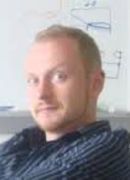Professor Chris Buckley

Distributed neural processing of self-generated visual input in a vertebrate brain
This project is co-supervised by Professor Leon Lagnado
During movement sensory input and motor output are bound in a closed-loop: motor actions shape sensory input and sensory inputs inform future motor commands. Studies over the last century have revealed that the neural circuits processing this closed-loop flow of information are widely distributed, i.e., including sensory and motor systems and intervening areas such as the cerebellum and basal ganglia. In this project, to characterise these brain-wide neural circuits, we will combine:
- A swimming virtual reality (VR) environment for larval zebrafish
- Light-sheet microscopy to image neurons across the brain
- Distributed computing techniques to analyse the large data sets produced by this setup with established (PCA, ICA) and leading edge analysis techniques (e.g. Granger causality)
- Computational modelling to construct, and subsequently test, the circuit mechanisms involved.
Example questions we will address are:
- What are the distributed neural circuits that allow fish to distinguish between the visual consequences of voluntary action (reafferent input) and visual input originating in the external environment (exafferent input).
- What are the distributed neural circuits that allow fish to detect when visual consequences of motor action (reafferent input) do not meet expectations?, indicating a failure to control their surrounding environment.
- Lastly how do fish distinguish between mismatch errors caused by external environment (exafferent input; as in Q1) and those caused by a failure to control their surrounding environment (as in Q2). We will construct, and test, a computational model of the observed circuit dynamics and computations.
This investigation will develop new algorithms to identify circuits in large neural datasets, elucidate the biological basis of closed-loop processing to inspire robotic control systems, and identify aspects of brain function that are contingent on closed-loop dynamics and thus may have been overlooked in traditional open-loop approaches.
This BBSRC funded project is a joint venture between myself (Department of Informatics) and Lagnado Lab (School of Life Sciences) and will involve both theory, modelling and experiment. Those involved with will receive training in cutting edge optical imaging techniques, technical aspects of instrument design, methods in computational modeling and the dominant theories in cognitive neuroscience. There will also be opportunities to visit theoretical collaborators at the RIKEN Brain Science Institute in Tokyo, Japan. Students with a background in a quantitative physical or computational science or in neuroscience are encouraged to apply.
Key references
- Hughes V. Mapping brain networks: Fish-bowl neuroscience. Nature. 2013;493: 466–468
- Ahrens MB, Orger MB, Robson DN, Li JM, Keller PJ. Whole-brain functional imaging at cellular resolution using light-sheet microscopy. Nat Methods. 2013;10: 413–420
- Seth AK, Barrett AB, Barnett L. Granger causality analysis in neuroscience and neuroimaging. J Neurosci. 2015;35: 3293–3297
- Buckley, C. L. and Toyoizumi, T., A theory of how active behavior stabilises neural activity: neural gain modulation by closed-loop environmental feedback. PLOS Comp. Biology (2018)
- Buckley, C. L. and Toyoizumi, T., The role of environmental feedback in a brain state switch from passive to active sensing. BMC Neuroscience 2013, 14(Suppl 1):P395.
You might also be interested in: